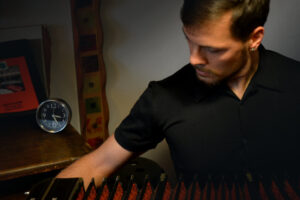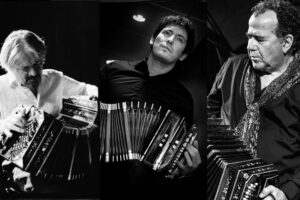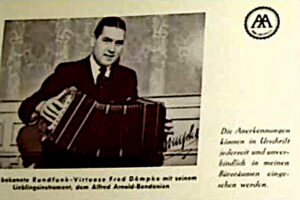
Optimizing Bandoneón Practice When Time is Short
Strategies to Perfect Bandoneón Practice There are times when musicians simply can’t dedicate as much time as they’d like to practicing, refining their skills, or
The project Duruflé meets the Bandoneón proposes an innovative exploration of the music of the great French composer Maurice Duruflé through the bandoneón, an instrument usually associated with tango.
My name is Omar Caccia. I was born in Italy in 1984. After studying Physics and graduating in 2008 from the University of Milan – Bicocca, I approached the bandoneón and in 2017 I decided to move to Buenos Aires to study this instrument in depth with a regular course of study at the Manuel de Falla Conservatory.
After discovering the music of Maurice Duruflé, I decided to undertake specific studies to learn about and disseminate his artistic work. Since 2023 I have been a member of the Association Maurice et Marie-Maddalene Duruflé.
Currently, my musical research focuses on the transcription and arrangement of organ, symphonic and opera music for solo bandoneón. In parallel, I dedicate myself to the spread of the bandoneón, both through public performances and through the creation of cultural and didactic content that I share through the video blog and on my YouTube channel.
The project Duruflé meets the Bandoneón aims to explore the music of Maurice Duruflé through an unprecedented interpretation, using the bandoneón, an instrument of German origin known above all for its primary role in Argentine tango.
The combination of Duruflé’s music and the bandoneón aims to achieve four main objectives:
When I accidentally discovered Duruflé’s music, I was literally thunderstruck. In Duruflé’s music I found the perfect synthesis and continuity between tradition and modernity.
Originally created to play German folk music, the bandoneón is an instrument of extraordinary versatility, capable of going beyond the context of tango in which it is nowadays almost exclusively used. Its acoustic and technical characteristics make it particularly interesting for adapting organ and polyphonic pieces. I invite you to read the following text for a technical dissertation on the bandoneón from an acoustic point of view.
The bandoneón is experiencing a second youth and is gaining year after year an ever-wider audience in the most disparate musical contexts: jazz, popular music, contemporary classical music.
The music of Maurice Duruflé is progressively expanding its consensus and recognition among an ever-larger audience. His compositions, rich in emotional depth and harmonic refinement, were for a long time known to limited contexts, but today, thanks to a renewed interest, they are finally receiving ever greater attention.
At a time when the public is increasingly hungry for artistic experiences that can nourish the soul, the combination of the bandoneón and Duruflé’s music appeared to me as a natural and inevitable choice. The bandoneón, with its ability to evoke a wide range of emotions and atmospheres, offers a new way of interpreting Duruflé’s works, making them accessible to anyone who wishes to immerse themselves in this timeless beauty.
The project, in its initial form, dates back about two years. It involves the video recording and dissemination of a piece by Duruflé that I’ve transcribed and adapted for the bandoneón.
The chosen piece for the video recording is “Chant Donné – Hommage a Jean Gallon.” It’s a short harmonization exercise on a given chant that Duruflé composed to honor his harmony teacher, Jean Gallon. Among Duruflé’s works, it’s considered the one that best condenses and synthesizes his style.
In my transcription, I’ve maintained the original structure of the work, especially the polyphonic texture, as much as possible. The bandoneón proved to be perfect for this, keeping the general harmonic feeling of the piece while adding its own unique personality. You can download the transcription here.
A demo of the bandoneón version, which I performed publicly on November 21, 2024, during the celebrations of the Centro Cultural Rojas of Buenos Aires, can be watched at this link.
In April 2025 a video was filmed at Bien Bohemio Bar, Buenos Aires. The idea was to choose a representative location in Buenos Aires, but which at the same time is not a location typically used to perform and record a piece by Duruflé and which does not give rise to an excessively forced juxtaposition.
The result is the video below.
Having recently completed the transcription and performance of Chant Donné, my focus has now shifted to finding the next captivating piece to adapt for the bandoneón. I’m excited to say I already have several promising candidates!
This kind of musical exploration demands significant time and energy, not only for the meticulous transcription and initial study but, most importantly, for the deep immersion of playing the piece repeatedly to discover its most effective interpretations.
Your encouragement and engagement are vital to this process. If you enjoy following my musical research on this website and my YouTube channel, please consider offering a small gesture of support – a like, share, or comment goes a long way and truly helps sustain my work.

Strategies to Perfect Bandoneón Practice There are times when musicians simply can’t dedicate as much time as they’d like to practicing, refining their skills, or

The project Duruflé meets the Bandoneón proposes an innovative exploration of the music of the great French composer Maurice Duruflé through the bandoneón, an instrument

In this bandoneón tutorial I explain the first of a series of preparatory exercises. After having dedicated a series of videos to the fundamental aspects

Learn about chromatic bandoneons! Download FREE PDF keyboard layouts for Peguri, Manoury, & Crosio-Caliero systems. Unisonoric bandoneon explained for beginners.

A Lesson from the Bandoneon to Move from Stage Panic to Expressiveness 2024 is coming to an end and I have been very busy during

Who is Fred Dömpke and why should deserve more consideration among the bandoneon players? The bandoneon is conquering a significant role in jazz. Many bandoneon